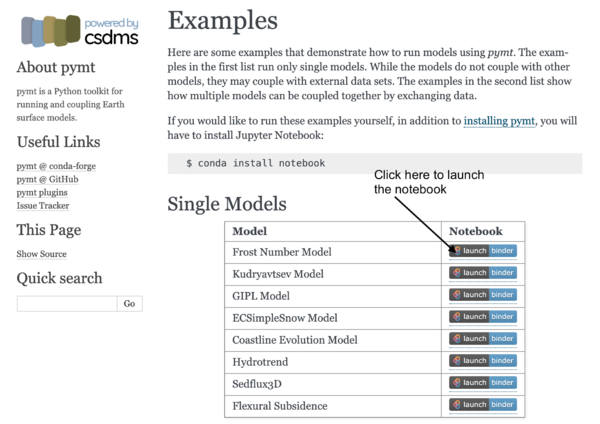Lab-0001: Difference between revisions
From CSDMS
No edit summary |
No edit summary |
||
| Line 72: | Line 72: | ||
}} | }} | ||
{{LabNotes | {{LabNotes | ||
|LabNotesInstructions= | |LabNotesInstructions=>> Open a new browser window and open the Pymt read the docs page at: https://pymt.readthedocs.io/en/latest/examples.html | ||
|LabNotesFigure= | |LabNotesFigure=ExampleListPymt.png | ||
|LabNotesFigureCaption=Caption of the figure | |LabNotesFigureCaption=Caption of the figure | ||
|LabNotesRequirements=-- | |LabNotesRequirements=-- | ||
|LabAcknowledgements=These labs are developed with support from NSF Grant 1503559, ‘Towards a Tiered Permafrost Modeling Cyberinfrastructure’ and are part of the Permafrost Modeling Toolbox, https://github.com/permamodel. | |LabAcknowledgements=These labs are developed with support from NSF Grant 1503559, ‘Towards a Tiered Permafrost Modeling Cyberinfrastructure’ and are part of the Permafrost Modeling Toolbox, https://github.com/permamodel. | ||
}} | }} | ||
Revision as of 17:31, 23 March 2020
Introduction to Permafrost Processes - Frost Number Model
This lab is part of the series Permafrost. Others in this series are:
- Permafrost Modeling - where does permafrost occur? (1 of 4)
- Permafrost Modeling - the Active Layer (2 of 4)
- Permafrost Modeling - making maps from gridded climate data (3 of 4)
- Permafrost Modeling - looking at future permafrost with climate models (4 of 4)
Contributor(s)
Irina Overeem at CSDMS, University of Colorado.
Mark Piper at CSDMS, University of Colorado.
Kang Wang at East China Normal University.
Elchin Jafarov at Los Alamos National Labs, NM.
Introduction
Lorem ipsum dolor sit amet, consetetur sadipscing elitr, sed diam nonumy eirmod tempor invidunt ut labore et dolore magna aliquyam erat, sed diam voluptua. At vero eos et accusam et justo duo dolores et ea rebum. Stet clita kasd gubergren, no sea takimata sanctus est Lorem ipsum dolor sit amet. Lorem ipsum dolor sit amet, consetetur sadipscing elitr, sed diam nonumy eirmod tempor invidunt ut labore et dolore magna aliquyam erat, sed diam voluptua. At vero eos et accusam et justo duo dolores et ea rebum. Stet clita kasd gubergren, no sea takimata sanctus est Lorem ipsum dolor sit amet. Lorem ipsum dolor sit amet, consetetur sadipscing elitr, sed diam nonumy eirmod tempor invidunt ut labore et dolore magna aliquyam erat, sed diam voluptua. At vero eos et accusam et justo duo dolores et ea rebum. Stet clita kasd gubergren, no sea takimata sanctus est Lorem ipsum dolor sit amet.
Duis autem vel eum iriure dolor in hendrerit in vulputate velit esse molestie consequat, vel illum dolore eu feugiat nulla facilisis at vero eros et accumsan et iusto odio dignissim qui blandit praesent luptatum zzril delenit augue duis dolore te feugait nulla facilisi. Lorem ipsum dolor sit amet, consectetuer adipiscing elit, sed diam nonummy nibh euismod tincidunt ut laoreet dolore magna aliquam erat volutpat.
Classroom organization
This lab is the first in a series of introduction to permafrost process modeling, designed for inexperienced users. In this first lesson, we explore the Air Frost Number model and learn to use such models in the CSDMS Python Model tool (Pymt). We implemented a basic configuration of the Air Frost Number (as formulated by Nelson and Outcalt in 1987). This lab is designed to gain some experience with running a numerical model, changing model inputs, and analyzing model output. Specifically, this first lab looks at what controls permafrost occurrence and compares the occurrence of permafrost in Russia.
Basic theory on the Air Frost Number is presented in File:FrostNumberModel Lecture1.pptx.
This lab will likely take ~ 1,5 hours to complete in the classroom. This time assumes you are unfamiliar with the Pymt and need to learn setting parameters, and looking at output (otherwise it will be much faster).
If you have never used the Python Modeling Tool (Pymt), learn how to use it at: https://pymt.readthedocs.io/en/latest. The Pymt allows you to set up simulations, and run them and then analyze data using Python.
If you are a faculty at an academic institution, it is possible to work with us to get temporary teaching accounts. Work directly with us by emailing: csdms@colorado.eduDownload associated file: FrostNumberModel Lecture1.pptx
Presentation describes basic theory on the Air Frost Number
Learning objectives
Skills
Skills
- Familiarize with a basic configuration of the Air Frost Number Model
- Make small changes to key input parameters
- See how to write a loop for calculations over a time series
- Hands-on experience with visualizing output in Python
Key concepts
- What is the primary control on the occurrence of permafrost
- Freezing and thawing day indices and how to approximate these
- Where in Russia permafrost occurs
- Critical evaluation of what the Air Frost number approximates
Lab notes
>> Open a new browser window and open the Pymt read the docs page at: https://pymt.readthedocs.io/en/latest/examples.html
Requirements
--
Acknowledgements
These labs are developed with support from NSF Grant 1503559, ‘Towards a Tiered Permafrost Modeling Cyberinfrastructure’ and are part of the Permafrost Modeling Toolbox, https://github.com/permamodel.
References


